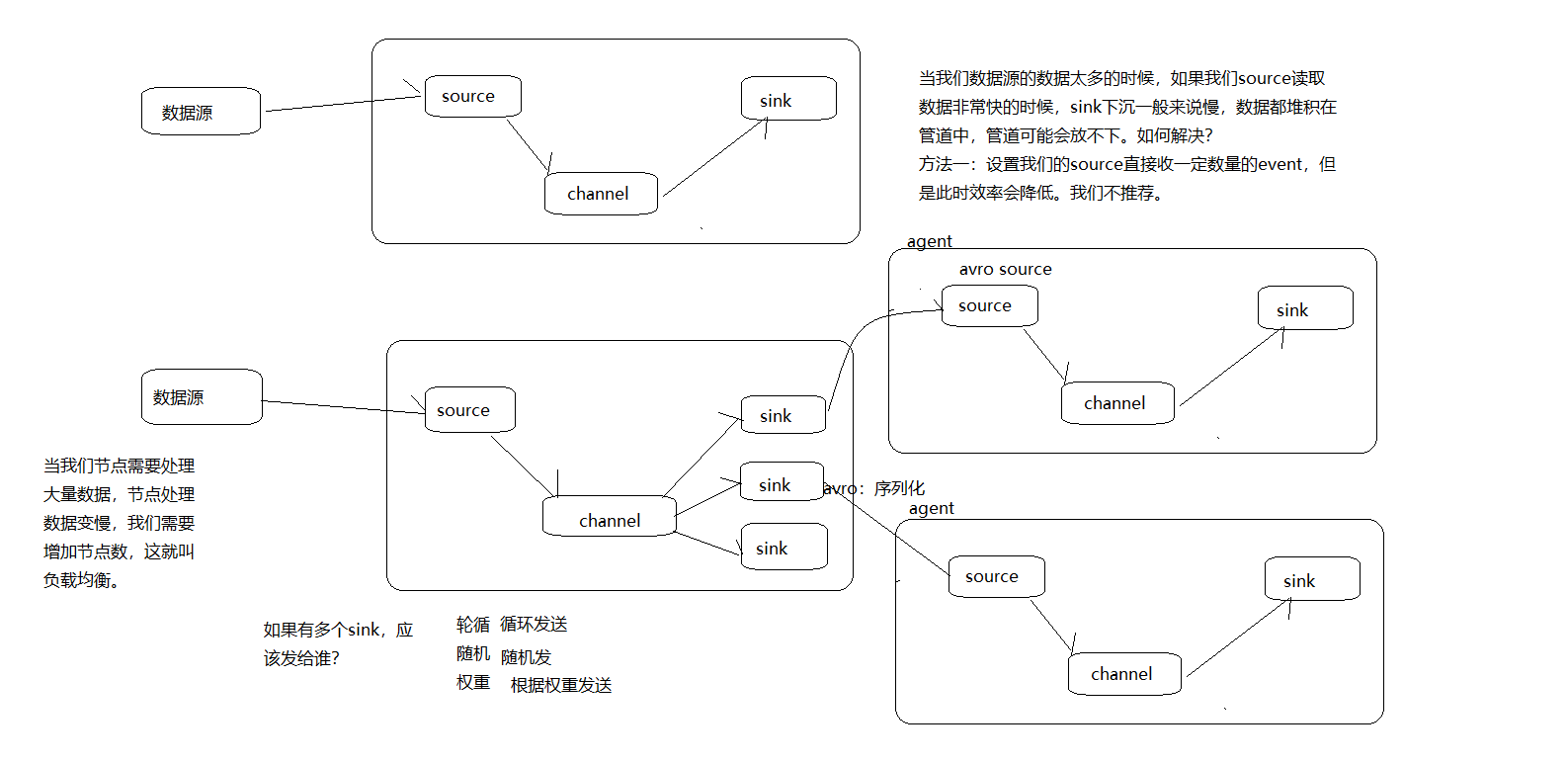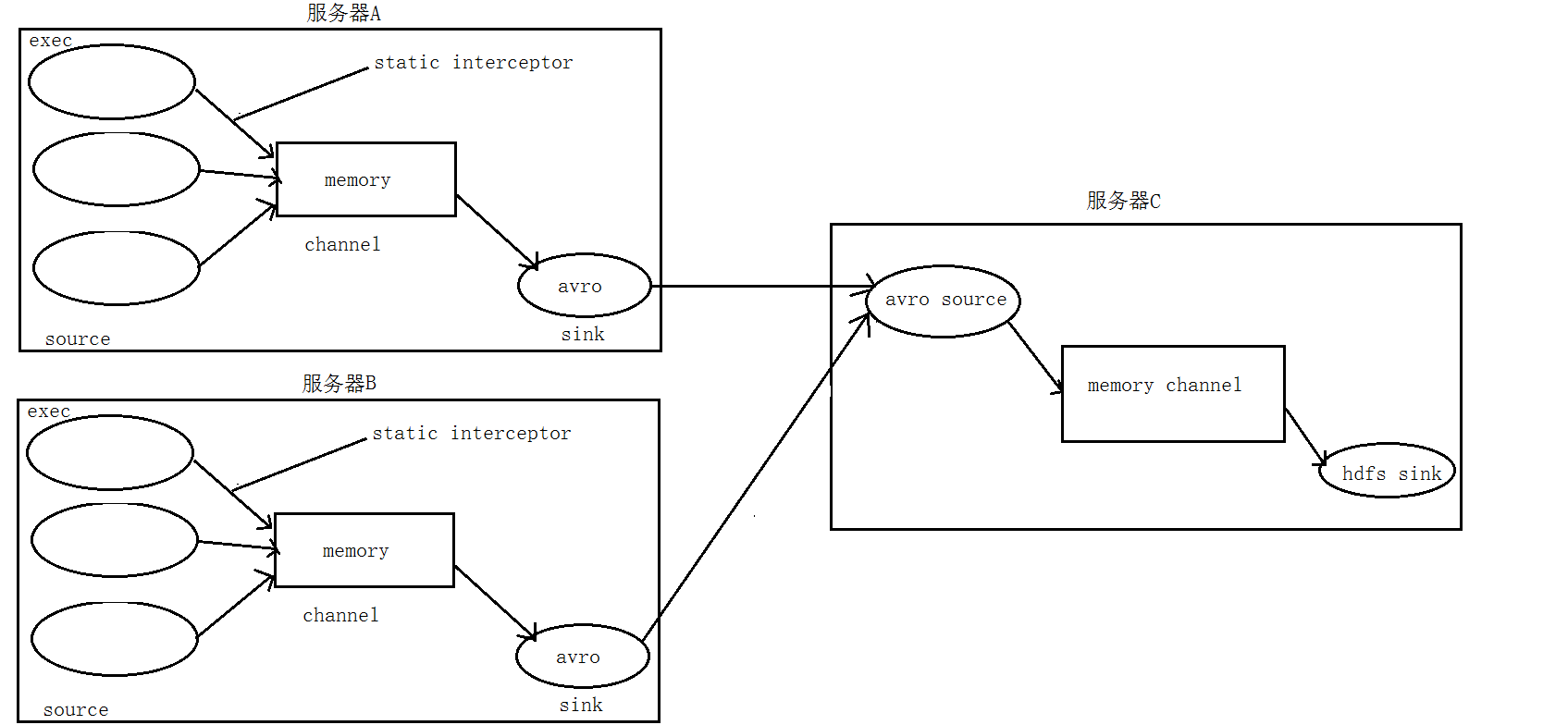Flume学习笔记
- 什么是Flume?
Flume是Cloudera提供的一个高可用的,高可靠的,分布式海量日志采集,聚合的传输软件
2. Flume架构

3.Flume的运行机制
Flume的核心角色是agent,本身是一个java进程,一般运行在日志收集节点,每个agent有以下三个组件
-
- source:采集源数据,跟数据源对接,获取数据。
- sink:下沉地,将采集的数据送往目的地,一般是下一个agent或者是直接存储到一个文件系统
- channle:传递数据管道,起到缓冲作用。】
- 在整个过程中流动的是event,它是flume内部传输数据最基本的单位,event将传输的数据进行封装,其中包括event header,event body,event信息,event信息就是flume收集到的日志记录。
4. 采集目录到hdfs
根据需求,在服务器下面的某个目录下会不断的产生新数据,我们需要收集这些新产生数据,然后上传到hdfs。
采集源source:spooldir
下沉目标sink:hdfs sink
传递通道channel:可用file channel 也可以用内存channel
# 三大组件的名字 a1.sources = r1 a1.sinks = k1 a1.channels = c1 # Describe/configure the source ##注意:不能往监控目中重复丢同名文件 a1.sources.r1.type = spooldir #文件的来源 a1.sources.r1.spoolDir = /root/logs a1.sources.r1.fileHeader = true # Describe the sink a1.sinks.k1.type = hdfs #下沉到哪里 a1.sinks.k1.hdfs.path = /flume/events/%y-%m-%d/%H%M/ #文件前缀 a1.sinks.k1.hdfs.filePrefix = events- #每隔十分钟产生一个文件夹(时间上的舍弃) a1.sinks.k1.hdfs.round = true a1.sinks.k1.hdfs.roundValue = 10 a1.sinks.k1.hdfs.roundUnit = minute #间隔多久将临时文件滚动 a1.sinks.k1.hdfs.rollInterval = 3 #当文件达到该大小滚动文件 a1.sinks.k1.hdfs.rollSize = 20 #当event事件数量达到5时滚动 a1.sinks.k1.hdfs.rollCount = 5 #批量写入hdfs个数 a1.sinks.k1.hdfs.batchSize = 1 a1.sinks.k1.hdfs.useLocalTimeStamp = true #生成的文件类型,默认是Sequencefile,可用DataStream,则为普通文本 a1.sinks.k1.hdfs.fileType = DataStream # Use a channel which buffers events in memory a1.channels.c1.type = memory a1.channels.c1.capacity = 1000 a1.channels.c1.transactionCapacity = 100 # Bind the source and sink to the channel a1.sources.r1.channels = c1 a1.sinks.k1.channel = c1
5. 采集文件到hdfs
当服务器有一个log日志文件不断有新数据写入,我们需要把这个新写入的数据采集到hdfs中。
-
-
下沉目标, 即sink ----hdfs文件系统: hdfs sink
-
source 和 sink 之间的传递通道---channel, 可以file channel 也可以使用内存 channel
6.Flume的负载均衡

agent1.channels = c1 agent1.sources = r1 agent1.sinks = k1 k2 #设置组 agent1.sinkgroups = g1 #set channel agent1.channels.c1.type = memory agent1.channels.c1.capacity = 1000 agent1.channels.c1.transactionCapacity = 100 agent1.sources.r1.channels = c1 agent1.sources.r1.type = exec agent1.sources.r1.command = tail -F /export/flumedata/123.log # set sink1 agent1.sinks.k1.channel = c1 agent1.sinks.k1.type = avro agent1.sinks.k1.hostname = node02 agent1.sinks.k1.port = 52020 # set sink2 agent1.sinks.k2.channel = c1 agent1.sinks.k2.type = avro
#下一个source的主机名 agent1.sinks.k2.hostname = node03 agent1.sinks.k2.port = 52020 #set sink group agent1.sinkgroups.g1.sinks = k1 k2 #负载均衡的配置 agent1.sinkgroups.g1.processor.type = load_balance # 是否开启黑名单机制 agent1.sinkgroups.g1.processor.backoff = true
#支持random agent1.sinkgroups.g1.processor.selector = round_robin
#设置超时时间(单位是毫秒),成指数倍增长 agent1.sinkgroups.g1.processor.selector.maxTimeOut=10000 开启命令
bin/flume-ng agent -c conf -f conf/exec-avro.conf -n agent1 -Dflume.root.logger=INFO,console
7. Flume的failover
具体流程和load balance一样,但内部原理完全不同,对其他每个节点设置优先值,当优先级最高的机器挂掉,另外一台比它低优先级的会开始代替它的工作,当宕机恢复后,他会恢复原来的优先级继续原来的工作,代替它工作这台继续作为备份。
a1.sinkgroups = g1 a1.sinkgroups.g1.sinks = k1 k2 k3 a1.sinkgroups.g1.processor.type = failover a1.sinkgroups.g1.processor.priority.k1 = 5 #优先级值, 绝对值越大表示优先级越高 a1.sinkgroups.g1.processor.priority.k2 = 7 a1.sinkgroups.g1.processor.priority.k3 = 6 a1.sinkgroups.g1.processor.maxpenalty = 20000 #失败的Sink的最大回退期(millis)
8. 拦截器
/source/logs/access/20160101/**
/source/logs/nginx/20160101/**
/source/logs/web/20160101/**

# Name the components on this agent a1.sources = r1 r2 r3 a1.sinks = k1 a1.channels = c1 # Describe/configure the source a1.sources.r1.type = exec a1.sources.r1.command = tail -F /root/data/access.log a1.sources.r1.interceptors = i1 a1.sources.r1.interceptors.i1.type = static ## static拦截器的功能就是往采集到的数据的header中插入自## 己定义的key-value对 a1.sources.r1.interceptors.i1.key = type a1.sources.r1.interceptors.i1.value = access a1.sources.r2.type = exec a1.sources.r2.command = tail -F /root/data/nginx.log a1.sources.r2.interceptors = i2 a1.sources.r2.interceptors.i2.type = static a1.sources.r2.interceptors.i2.key = type a1.sources.r2.interceptors.i2.value = nginx a1.sources.r3.type = exec a1.sources.r3.command = tail -F /root/data/web.log a1.sources.r3.interceptors = i3 a1.sources.r3.interceptors.i3.type = static a1.sources.r3.interceptors.i3.key = type a1.sources.r3.interceptors.i3.value = web # Describe the sink a1.sinks.k1.type = avro a1.sinks.k1.hostname = 192.168.200.101 a1.sinks.k1.port = 41414 # Use a channel which buffers events in memory a1.channels.c1.type = memory a1.channels.c1.capacity = 20000 a1.channels.c1.transactionCapacity = 10000 # Bind the source and sink to the channel a1.sources.r1.channels = c1 a1.sources.r2.channels = c1 a1.sources.r3.channels = c1 a1.sinks.k1.channel = c1
#定义agent名, source、channel、sink的名称 a1.sources = r1 a1.sinks = k1 a1.channels = c1 #定义source a1.sources.r1.type = avro a1.sources.r1.bind = 192.168.72.143 a1.sources.r1.port =41414 #添加时间拦截器 a1.sources.r1.interceptors = i1 a1.sources.r1.interceptors.i1.type = org.apache.flume.interceptor.TimestampInterceptor$Builder #定义channels a1.channels.c1.type = memory a1.channels.c1.capacity = 20000 a1.channels.c1.transactionCapacity = 10000 #定义sink a1.sinks.k1.type = hdfs a1.sinks.k1.hdfs.path=hdfs://192.168.72.141:8020/source/logs/%{type}/%Y%m%d a1.sinks.k1.hdfs.filePrefix =events a1.sinks.k1.hdfs.fileType = DataStream a1.sinks.k1.hdfs.writeFormat = Text #时间类型 a1.sinks.k1.hdfs.useLocalTimeStamp = true #生成的文件不按条数生成 a1.sinks.k1.hdfs.rollCount = 0 #生成的文件按时间生成 a1.sinks.k1.hdfs.rollInterval = 30 #生成的文件按大小生成 a1.sinks.k1.hdfs.rollSize = 10485760 #批量写入hdfs的个数 a1.sinks.k1.hdfs.batchSize = 10000 #flume操作hdfs的线程数(包括新建,写入等) a1.sinks.k1.hdfs.threadsPoolSize=10 #操作hdfs超时时间 a1.sinks.k1.hdfs.callTimeout=30000 #组装source、channel、sink a1.sources.r1.channels = c1 a1.sinks.k1.channel = c1
在flume安装目录下执行 : bin/flume-ng agent -c conf -f conf/avro_source_hdfs_sink.conf -name a1 -Dflume.root.logger=DEBUG,console 在flume安装目录下执行 : bin/flume-ng agent -c conf -f conf/exec_source_avro_sink.conf -name a1 -Dflume.root.logger=DEBUG,console while true; do echo "access access ....">> /export/flumedata/access.log;sleep 1;done while true; do echo "web web ....">> /export/flumedata/web.log;sleep 1;done while true; do echo "nginx nginx ....">> /export/flumedata/nginx.log;sleep 1;done
9. 自定义拦截器
https://www.jianshu.com/p/ce5d5ab8e6e9



